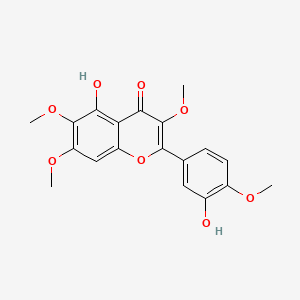| MeSH term | MeSH ID | Detail |
|---|---|---|
| Lung Neoplasms | D008175 | 171 associated lipids |
| Colonic Neoplasms | D003110 | 161 associated lipids |
| Prostatic Neoplasms | D011471 | 126 associated lipids |
| Glioma | D005910 | 112 associated lipids |
| Carcinoma, Hepatocellular | D006528 | 140 associated lipids |
| Bronchial Spasm | D001986 | 18 associated lipids |
| Carcinoma, Non-Small-Cell Lung | D002289 | 72 associated lipids |
Casticin
Casticin is a lipid of Polyketides (PK) class. The involved functions are known as Ligand Binding. The related lipids are linoleates.
Cross Reference
Introduction
To understand associated biological information of Casticin, we collected biological information of abnormalities, associated pathways, cellular/molecular locations, biological functions, related genes/proteins, lipids and common seen animal/experimental models with organized paragraphs from literatures.
What diseases are associated with Casticin?
There are no associated biomedical information in the current reference collection.
Possible diseases from mapped MeSH terms on references
We collected disease MeSH terms mapped to the references associated with Casticin
PubChem Associated disorders and diseases
What pathways are associated with Casticin
There are no associated biomedical information in the current reference collection.
PubChem Biomolecular Interactions and Pathways
Link to PubChem Biomolecular Interactions and PathwaysWhat cellular locations are associated with Casticin?
There are no associated biomedical information in the current reference collection.
What functions are associated with Casticin?
Related references are published most in these journals:
| Function | Cross reference | Weighted score | Related literatures |
|---|
What lipids are associated with Casticin?
Related references are published most in these journals:
| Lipid concept | Cross reference | Weighted score | Related literatures |
|---|
What genes are associated with Casticin?
There are no associated biomedical information in the current reference collection.
What common seen animal models are associated with Casticin?
There are no associated biomedical information in the current reference collection.
NCBI Entrez Crosslinks
All references with Casticin
Download all related citations| Authors | Title | Published | Journal | PubMed Link |
|---|---|---|---|---|
| Wu ZY et al. | Casticin Inhibits A375.S2 Human Melanoma Cell Migration/Invasion through Downregulating NF-κB and Matrix Metalloproteinase-2 and -1. | 2016 | Molecules | pmid:27007357 |
| Shih YL et al. | Casticin induces DNA damage and inhibits DNA repair-associated protein expression in B16F10 mouse melanoma cancer cells. | 2016 | Oncol. Rep. | pmid:27572101 |
| Wang C et al. | Casticin inhibits lipopolysaccharide-induced acute lung injury in mice. | 2016 | Eur. J. Pharmacol. | pmid:27450485 |
| Chung YH and Kim D | RIP kinase-mediated ROS production triggers XAF1 expression through activation of TAp73 in casticin-treated bladder cancer cells. | 2016 | Oncol. Rep. | pmid:27349281 |
| Shiue YW et al. | Casticin Induced Apoptosis in A375.S2 Human Melanoma Cells through the Inhibition of NF-[Formula: see text]B and Mitochondria-Dependent Pathways In Vitro and Inhibited Human Melanoma Xenografts in a Mouse Model In Vivo. | 2016 | Am. J. Chin. Med. | pmid:27109154 |
| Li YJ et al. | Flavonoids casticin and chrysosplenol D from Artemisia annua L. inhibit inflammation in vitro and in vivo. | 2015 | Toxicol. Appl. Pharmacol. | pmid:25891417 |
| Lee H et al. | Casticin, an active compound isolated from Vitex Fructus, ameliorates the cigarette smoke-induced acute lung inflammatory response in a murine model. | 2015 | Int. Immunopharmacol. | pmid:26321116 |
| Rasul A et al. | Molecular mechanisms of casticin action: an update on its antitumor functions. | 2014 | Asian Pac. J. Cancer Prev. | pmid:25422178 |
| Liu F et al. | Casticin suppresses self-renewal and invasion of lung cancer stem-like cells from A549 cells through down-regulation of pAkt. | 2014 | Acta Biochim. Biophys. Sin. (Shanghai) | pmid:24247269 |
| Liou CJ et al. | Casticin inhibits COX-2 and iNOS expression via suppression of NF-κB and MAPK signaling in lipopolysaccharide-stimulated mouse macrophages. | 2014 | J Ethnopharmacol | pmid:25446583 |
